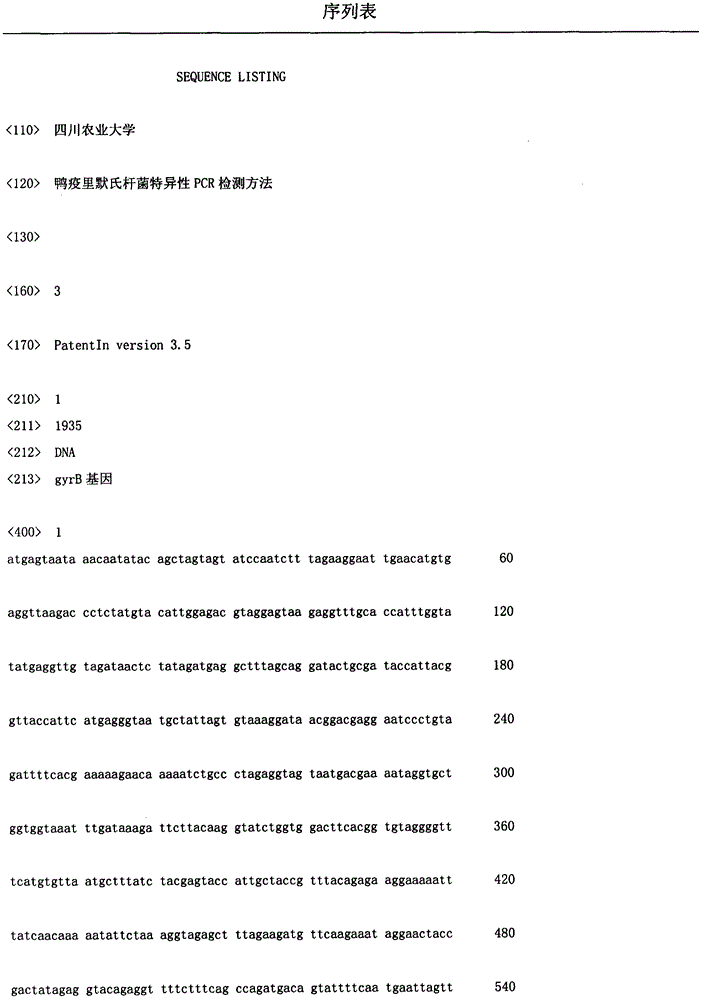Specific PCR detection method of Riemerella anatipestifer
A technology of Riemer's anatipestifer and a detection method is applied in the field of specific PCR detection of Riemerella anatipestifer, which can solve problems such as unfavorable diagnosis of etiology, investigation of pathogenic conditions, economic loss of duck breeding industry, harm to duck breeding industry, and the like. To achieve the effect of simple result judgment, short detection time, and reduced detection cost
- Summary
- Abstract
- Description
- Claims
- Application Information
AI Technical Summary
Problems solved by technology
Method used
Image
Examples
Embodiment 1
[0015] Establishment of PCR method for Riemerella anatipestifer
[0016] Through bioinformatics analysis, the gyrB gene, which plays an important role in the process of specific DNA transcription, replication, recombination and repair, was found from the genomic DNA sequence of Riemerella anatipestifer, and it was used as the detection target gene of Riemerella anatipestifer. The sequence is shown in SEQ ID NO: 1;
[0017] The DNA sequence of this gene is imported in the primer design software Primer Premier 5.0 to design primers, the setting GC% range is 40-60%, and the product size range is 150-300bp, selects primers from the alternative primer pair, and the primer sequences are as follows ( Primers were synthesized by Shanghai Yingjun Technology Service Co., Ltd.):
[0018] GYRB-L: 5'-AGAGCGAGAAGAAAAAACCT-3' (SEQ ID NO: 2);
[0019] GYRB-R: 5'-CTCCCATAAGCATAGAGAAGA-3' (SEQ ID NO: 3);
[0020] Step 2, preparation of DNA template
[0021] Inoculate the strains of various ...
Embodiment 2
[0028] PCR specificity evaluation experiment
[0029] According to the DNA template extraction method and PCR detection method in Implementation 1, Escherichia coli, Salmonella, Staphylococcus aureus, Pasteurella multocida, Bacillus pumilus, Streptococcus, Salmonella typhimurium, Salmonella Dublin, Salmonella pullorum, Standard strains such as Riemerella anatipestifer (as shown in Table 1, the strains shown in the table are all obtained by those skilled in the art through open channels) were subjected to amplification reactions.
[0030] For the test results of the specificity test, see figure 1 , please refer to the accompanying drawings for negative control strains and strain numbers. In the picture: Lanes 1-10: Pasteurella.multiocida PM966, Salmonella CMCC 50083-4, Staphylococcus aureus ATCC 6538, Escherichia 046, Streptococcus CMCC32223, Bacillus pumilus subtil CMCC63202 strain, Salmonella.typhimurium 50115-13 strain, Salmonella.dulin 50761 strain, Salmonella pullorum 50...
Embodiment 3
[0035] PCR sensitivity evaluation experiment
[0036] The Riemerella anatipestifer template DNA obtained by extracting in Example 1 was measured by OD260 / 280, and the concentration of the total DNA solution of Riemerella anatipestifer was 350 ng / μl, and was diluted 10 times with sterile water, and co-diluted 6 gradients, 1 μL of each gradient was added to the PCR reaction system, the amplified product was detected by gel electrophoresis, and the gel electrophoresis results were observed in a gel imager; figure 2As shown in the figure: lanes 1-6: reactions with DNA template contents of 350ng, 35ng, 3.5ng, 350pg, 35pg, 3.5pg and 350fg respectively; lane 7: ddH 2 O; Lane M: DL2000bp molecular weight standard. Depend on figure 2 It can be seen that a clear band can be seen in the fifth lane, corresponding to a DNA concentration of 35 pg, which has good sensitivity.
PUM
 Login to View More
Login to View More Abstract
Description
Claims
Application Information
 Login to View More
Login to View More - R&D
- Intellectual Property
- Life Sciences
- Materials
- Tech Scout
- Unparalleled Data Quality
- Higher Quality Content
- 60% Fewer Hallucinations
Browse by: Latest US Patents, China's latest patents, Technical Efficacy Thesaurus, Application Domain, Technology Topic, Popular Technical Reports.
© 2025 PatSnap. All rights reserved.Legal|Privacy policy|Modern Slavery Act Transparency Statement|Sitemap|About US| Contact US: help@patsnap.com



